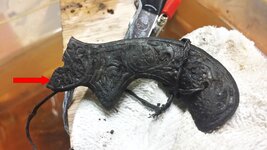alderan33
Full Member
- Oct 15, 2010
- 249
- 39
- Detector(s) used
- Whites Spectra V3I
Garrett Pro Pointer
Minelab Etrac
- Primary Interest:
- Relic Hunting




There are five items that need Id's.
The first item is a large piece of brass sheeting that was crumpled almost beyond recognition. It sat in my garage for two years before I finally got around to examining it. The only reason I kept is was because I was able to discern what I thought was a "6" (which turned out to be a 9) and the words, "Rock Island Arsenal". I hammered in out on the ground and discovered that it was actually a cavalry insignia. Can anyone tell me what this might have been used for?
The second item is a pistol handle. I doubt we will be able to positively ID it until electrolysis is complete as I believe there are numbers hidden below the rust.
The third item is a piece of brass adorned with acorns and leaves similar to the designs I have seen on the dress helmets.
Item four is a small circular piece of brass that looks like a top or something but isn't.
Item five is also brass. It is in two pieces and has circular bevels on it.
Thanks for any help. HH


 Henry V. Allien
Henry V. Allien


 ?
?

